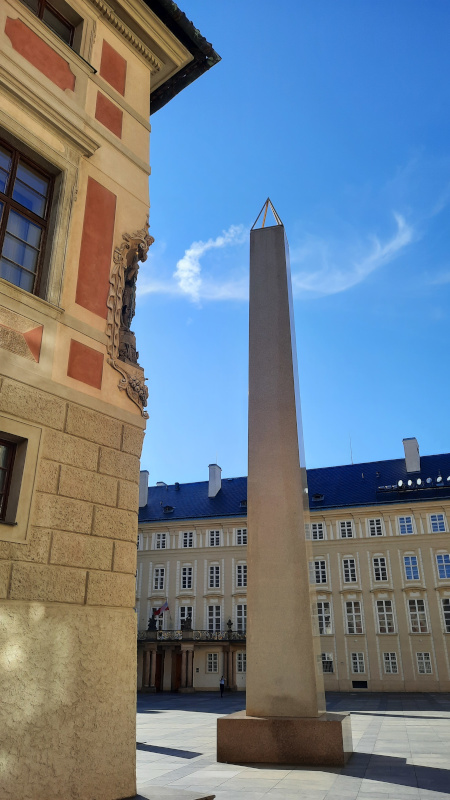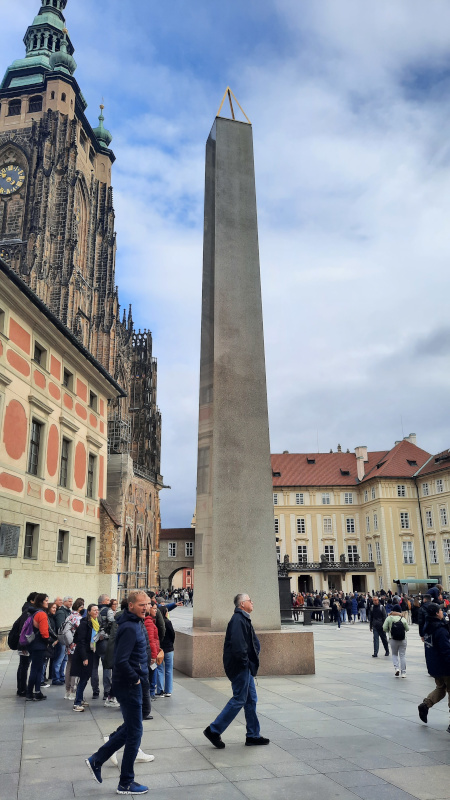Memorials – The Prague Castle Obelisk
Consider that the original idea for a simple memorial plaque to Czechs and Slovaks killed in World War One would end up with hundreds of tons of granite being mined, the military involved in transporting different versions and the final version installed in a different place than originally intended. The story of the Prague Castle Obelisk is an interesting look at a time when anything was possible.

The Memorial Idea
In May 1921 the first Czechoslovak President Tomáš Garrigue Masaryk requested a memorial plaque to raised to all the Czechs and Slovaks who died in the First World War. The request required that this be implemented before the next Independence Day i.e. October 28th 1921. This clearly did not work out because the Castle Architect, a man called Josip Plečník, countered with a suggestion for an obelisk to be placed in the Paradise Garden (a part of the Castle south gardens) and all of this would be paid by public funds.
The First Attempt

On August 4th 1921 a general tender was announced to supply a Prague Castle Obelisk with a height between 30m and 34m. Nothing happened. Finally, in December 1922 the Mrakotin Stone Company said that it could supply an obelisk but only to a maximum height of 19m. By April 1923 an order was made for two items. First was granite for a bowl to be used as a fountain (this item becomes significant later) and second was a piece of granite for the obelisk. When broken out from the Mrakotin Quarry the granite for the obelisk was 20m long and weighed 120 tons. Both obelisk and bowl were to be installed in the Paradise Garden.
The End of the First Attempt
The obelisk and the bowl were transported to a nearby road where they were worked on. This reduced the height of the obelisk to 18.2m and the weight down to just over 91 tons. A new 11km railway spur was built to the nearest train station (Telc) and two heavy bogies were made to carry the obelisk. At the bottom of a hill, the obelisk was separated from the bowl to be transported but during this process the obelisk slid, uncontrolled, back down the hill. It hit the bowl (which itself would have weighed @50 tons at that time) and the top 6.3 metres of the obelisk granite broke off.
What Happened to the Pieces?
The bowl continued it’s journey and was positioned in the Paradise Garden of the Castle south gardens. The smaller 6.3 metre part of the obelisk stayed in the area where it was broken and is currently in the Telč Square of Heroes. The larger part of the obelisk was transported to Prague but not to the Castle. Instead you’ll find it close to Palackého Naměsti in the second district. This part was also partly damaged by the Nazis and the version you see now is from 1998. It commemorates specifically the Prague citizens killed in the First World War.
The Second Attempt

The second version of the Prague Castle Obelisk was requested in November 1923 and paid for by President Masaryk himself. After rejecting one piece of granite due to poor quality a second length was broken out of the Mrakotin Quarry on September 8th 1925. At 19m it was similar to the earlier version but again, when lifted for transport it broke. This time 3.3m was lost but it still left 15.6m weighing @112 Tons. This did not fit with the Castle Architect’s original plan for locating the obelisk in the Paradise Garden along with the bowl so he changed the location of the Prague Castle Obelisk to the 3rd Courtyard.
This second piece of granite then began it’s journey from the quarry to Prague. It took 19 days to get from the quarry to the closest railway station at Telč. It took 7 days to get from Telč to the Prague Dejvice railway station where it was stored for the winter of 1925/26.
In the spring of 1926 the final leg of the route. A 1.4 kilometre journey from the Dejvice railway station to the Castle 3rd courtyard. You can walk it in 22 minutes. The piece of granite took 22 days and that’s where it stayed, in the 3rd courtyard of Prague Castle for two and a half years being worked into what you see today which corresponds to the original 1923 design. A 15.42 metre obelisk weighing almost 96 tonnes, it is anchored 3.8 metres into the ground by an iron prism. The 3x3m base descends 20cm into the ground.
The finished Prague Castle Obelisk was officially unveiled on the 10th Anniversary of the republic on October 28th 1928 and took 6 days to position. As I mentioned earlier, although it contains no text it is commemorating all Czechs and Slovaks who died in the First World War.
Interesting Trivia
There is a hollow space under the obelisk which can be accessed from the adjacent Old Deanery building because there was a possibility that underneath the obelisk would be the tomb of an unknown soldier but this plan was never implemented. The top of the Prague Castle Obelisk is terminated by a Pyramidion which is made from gold-plated steel and was unveiled only on May 13th 1996.
Something Related or a Few Minutes Away
Prague Castle Imperial Gardens
President Tomáš Garrigue Masaryk
